Netanyahu ousts Likud party activist for telling protesters he wishes ‘another 6 million would burn’
TEL AVIV (JTA) — Israeli Prime Minister Benjamin Netanyahu expelled a prominent activist from his Likud Party after the activist was filmed calling protesters “whores” and saying that he wishes “another six million would burn,” a reference to the Holocaust.
The activist, Itzik Zarka, directed the epithets at protesters who were demonstrating on Saturday night against Netanyahu’s effort to weaken the judiciary. Weekly protests have occurred nationwide against the planned judicial overhaul, a key portion of which is set to advance to a final vote in the coming weeks.
“You whores, burn in hell, burn in hell,” Zarka screamed at a demonstration near the northern Israeli city of Beit Shean. “It’s not for nothing that six million went. I’m proud, I’m proud. I wish another six million would burn.”
His comments, which were condemned by a wide range of senior Likud politicians, were a crude allusion to a perceived ethnic split in Israel between supporters and opponents of the judicial overhaul, and to a longstanding grievance that supporters of the overhaul hope to address.
The vast majority of the country’s founding left-wing elite was Ashkenazi, or Jews of European descent, and enacted discriminatory policies that disadvantaged Mizrahim, or Jews of Middle Eastern descent, particularly in the country’s early decades. Correspondingly, Mizrahi voters have long formed a key part of the right-wing Likud’s base, while the core of the country’s shrinking left has historically been Ashkenazi.
Some supporters of the overhaul say that the Supreme Court is a holdout of an upper-class Ashkenazi elite, and that it wields disproportionate political sway. The overhaul’s opponents, by contrast, say the proposed legislation sapping the Supreme Court’s power will endanger Israeli democracy.
But for even the strongest proponents of the overhaul, Zarka’s comments seemingly wishing for another Holocaust crossed the brightest of red lines. Zarka is a longtime Likud supporter who has been photographed with the party’s leaders, including Netanyahu.
״We will not accept this kind of shameful conduct in the Likud movement,” read a statement on Sunday from the party, which said Netanyahu ordered Zarka’s ouster. “We forcefully condemn Itzik Zarka’s words and completely distance ourselves from them. We will not accept or include shocking statements of this kind.”
Yariv Levin, Israel’s justice minister and the lead architect of the judicial overhaul, said in a statement that “there’s no place for that type of behavior and comments, anywhere or in any context.”
On his Facebook account, which features a photo of him kissing Netanyahu on the cheek, Zarka has repeatedly apologized for what he called his “terrible words.” He wrote that he was accosted by protesters, that his words were taken out of context and that he is a descendant of a Holocaust survivor. He wrote that as penance, he would like to connect with a Holocaust survivor to provide them with company and food.
“I apologize in the name of all of the Jewish people in Israel and the Diaspora,” he wrote. “We know what the Jews of European countries experienced in the Holocaust, and I apologize from the depths of my soul.”
At the heart of the film ‘Oppenheimer’ is a clash between real-life Jews
(JTA) — In 1945 physicist J. Robert Oppenheimer was a national hero, hailed as the “father of the atomic bomb” and the man who ended World War II.
Less than a decade later, he was a pariah, after the United States Atomic Energy Commission revoked his security clearance following allegations about his left-leaning politics at the height of the anti-communist McCarthy era.
Christopher Nolan’s biopic, “Oppenheimer,” which opens in theaters on July 21, will star Irish actor Cillian Murphy as the famous scientist. But it will also feature Robert Downey Jr. as a lesser known real-life character, Lewis Strauss (pronounced “Straws”), the chairman of the AEC and one of Oppenheimer’s chief inquisitors.
The clash between the scientist and the bureaucrat was a matter of personalities, politics and the hydrogen bomb (Strauss supported it, Oppenheimer was opposed). But according to amateur historian Jack Shlachter, the two represented opposites in another important way: as Jews. Shlachter has researched how Oppenheimer’s assimilated Jewish background and Strauss’ strong attachment to Jewish affairs set them up for conflict as men who represented two very different reactions to the pressures of acculturation and prejudice in the mid-20th century.
Shlachter is in a unique position to explore the Jewish backstory of Oppenheimer: A physicist, he worked for more than 30 years at Los Alamos National Laboratory, the New Mexico complex where Oppenheimer led the Manhattan Project that developed the bomb. Shlachter is also a rabbi, ordained in 1995, who leads HaMakom, a congregation in Santa Fe, New Mexico, as well as the Los Alamos Jewish Center.
“A hero of American science, [Oppenheimer] lived out his life a broken man and died in 1967 at the age of 62,” The New York Times wrote last December, after the secretary of energy nullified the 1954 decision to revoke Oppenheimer’s security clearance. Lewis Strauss died in 1974 at age 77; his funeral was held at New York’s Congregation Emanu-El, where he had been president from 1938 to 1948.
When I asked Shlachter what drew him to the story of Oppenheimer and Strauss, he told me, “At this later stage of my life, I realized that things are not black and white. The common narrative that I think I have heard in town puts Oppenheimer at 100 and Strauss at zero. I just tried to balance that a little bit, and I thought that their Jewishness was one way to see that there’s some nuance in the relationship.”
Our conversation was edited for length and clarity.
There has been a lot of talk about Oppenheimer in anticipation of the Christopher Nolan film, but I haven’t seen much on his Jewish background. I guess as a rabbi and a physicist at Los Alamos this was a subject you couldn’t resist.
I am speaking as a private citizen, not on behalf of Los Alamos National Laboratory or anything like that. Oppenheimer was the first director of what is now Los Alamos National Laboratory. He was the scientific leader of the Manhattan Project. And it was really his doing that the laboratory ended up in northern New Mexico. He has been out here as a late teen and really fell in love with the desert Southwest.
His Jewishness is a bit complicated. His father was an immigrant from Germany in the late 1800s. And his mother was a first-generation American but her parents had emigrated to the United States. And in their approach to religion, they became enamored with the Ethical Culture Society of Felix Adler.
That’s the non-sectarian movement that had roots in Reform Judaism and is based on the idea that morality does not need to be grounded in religious or philosophical dogma.
Correct. Samuel Adler, Felix’s father, was brought over from Germany to serve as the rabbi of New York’s Temple Emanu-El, then and now a major Reform synagogue. They sent Felix back to Germany to study and he got his PhD in Heidelberg, and the plan had been for Felix Adler to succeed his father at some point. He came back in his 20s and gave what was his first and last sermon at Temple Emanu-El. He had adopted and absorbed some ideas while he was in Germany that were completely anathema to the Reform community, and he spun off the Ethical Culture Society.
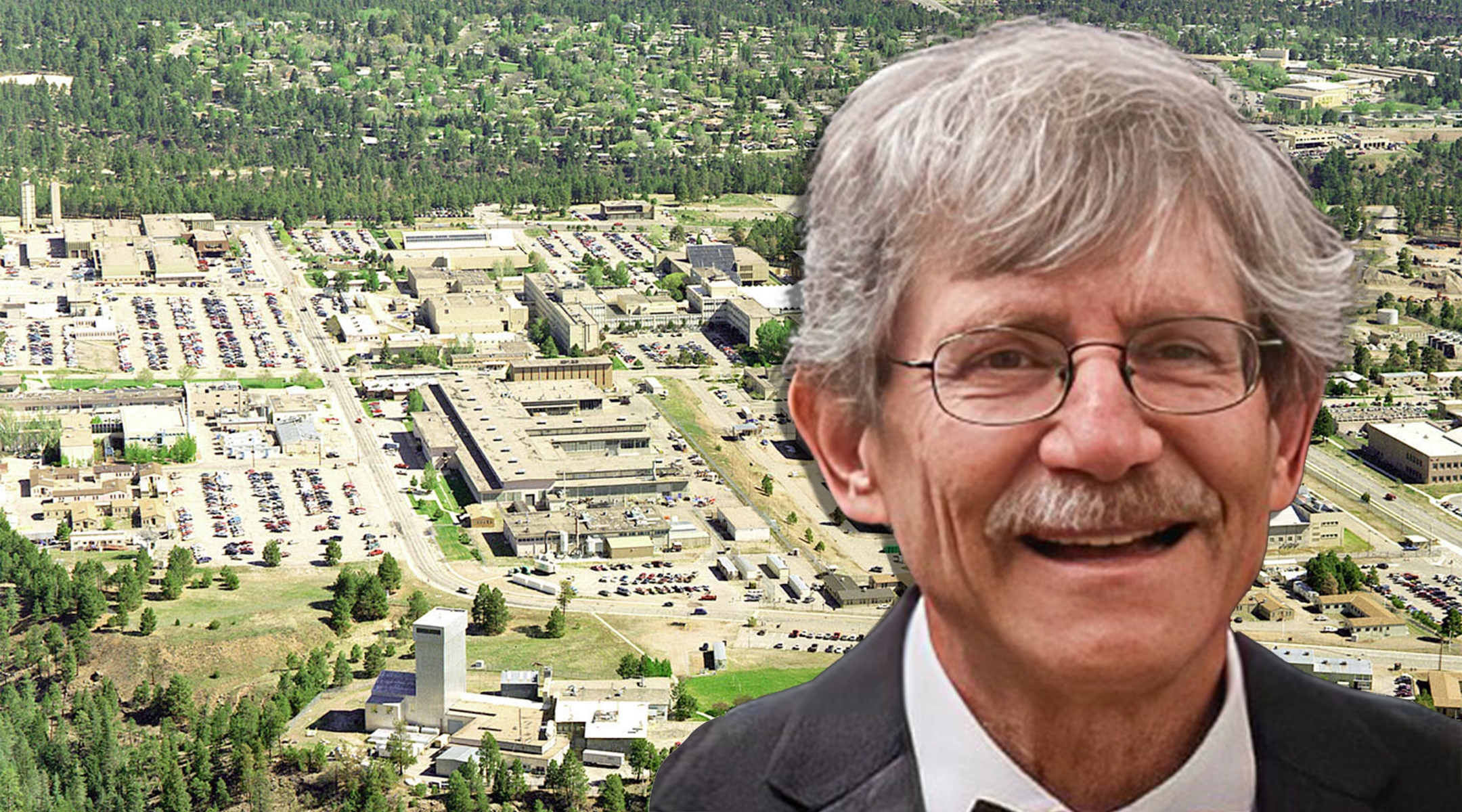
Rabbi Jack Shlachter worked for 30 years as a physicist at Los Alamos National Laboratory (in background). (Courtesy; Los Alamos National Laboratory)
Julius Oppenheimer, Robert’s father, was a trustee of the Ethical Culture Society, and Felix Adler conducted the wedding ceremony of Julius to Ella Oppenheimer, Robert’s mother. J. Robert Oppenheimer was educated at the Ethical Culture school. It was supposed to be non-religious and yet it was clearly dominated by Jews. It was one of these things about being American through and through, and somehow not having Judaism stand in the way. I think that really shaped Oppenheimer’s approach to Judaism.
Was there an ethos that he might have absorbed from the Ethical Cultural school that would have been important either in his left-wing politics or in his approach to the Manhattan Project?
My suspicion is yes, because Felix Adler in his training in Germany had become quite interested in Karl Marx and in the plight of the working class, and it seems impossible to me that that didn’t get somehow transmitted at the Ethical Culture school. It does not surprise me that Oppenheimer’s politics were left leaning.
As an adult, did Oppenheimer ever talk about his Judaism publicly or explain what his connection was to either the people or the faith?
Almost not at all, although there are some quite interesting quotes from other people. The Nobel laureate physicist Isidor Isaac Rabi and Oppenheimer were quite close, and Rabi testified on Oppenheimer’s behalf at the security hearing in 1954. According to Ray Monk’s massive biography of Oppenheimer, Rabb says that “what prevented Oppenheimer from being fully integrated was his denial of a centrally important part of himself: his Jewishness.” And Felix Bloch, who was another Jewish physicist who went on to win the Nobel Prize, said that Oppenheimer tried to act as if he were not a Jew, and succeeded because he was a good actor. You know, when you can’t integrate yourself and you’re trying to distance yourself from your roots, you can become conflicted. That’s Rabi’s assessment of Oppenheimer’s connection to Judaism.
But you also found a few instances of Oppenheimer positively engaging with Jews and Judaism.
In 1934, when Oppenheimer was a professor at Berkeley, he earmarked 3% of his salary for two years to help Jewish scientists emigrate from Germany. I think the fact that they were scientists was the important thing, and of course they were Jewish, because they’re the ones who were trying to get out in 1934. I don’t know that he was doing this because they were Jews or because they were scientists. Supposedly, Oppenheimer sponsored his aunt and cousin to emigrate from Germany, and then he continued to assist them after they came to the United States.
And then in 1954, at the security clearance hearing, Oppenheimer said that starting in late 1936, he developed “a continuing, smoldering fury about the treatment of Jews in Germany.” I don’t know if you had gone back to 1936 that you would have found any evidence of him saying that at the time. I doubt it. But one thing to remember is that in Oppenheimer’s lifetime, antisemitism was not non-existent. Antisemitism shaped how people dealt with their Judaism and this was the way he dealt with it.
So fast forward, Oppenheimer grew up well-to-do in New York and was educated at Harvard and then in Europe, where he studied physics at the University of Cambridge and the University of Göttingen. He joins the staff at the Lawrence Radiation Laboratory at Berkeley, and he begins socializing with leftist professors — both communists and so-called fellow travelers, deeply involved in workers’ rights and supporting the anti-fascists in the Spanish Civil War — in ways that are going to come back to haunt him in the 1950s. In the “American Prometheus” biography, which Nolan’s film is based on, we learn that Oppenheimer’s political activities came to the attention of the FBI at this point, years before his work on the atom bomb project.
That’s correct. He clearly had sympathy for those causes. And I would say understandably. There was a depression going on in this country, and the workers’ condition was not perfect.
There are now historians who are claiming Oppenheimer really was a card-carrying communist despite his denials. He certainly was a fellow traveler, his brother Frank was clearly a card-carrying communist as was Robert’s future wife Kitty.
In 1942 Lieutenant Colonel Leslie Grove was appointed director of what became known as the Manhattan Project, and selected Oppenheimer to head the project’s secret weapons laboratory.
Groves and Oppenheimer seem to have a chemistry which was critical for the success of the project. Why Groves figured that Oppenheimer was the guy to lead it is a little bit of a mystery. Oppenheimer had not led anything even remotely like this. He was a theoretical physicist, and you’re talking about huge experimental facilities for the project. And he wasn’t yet 40. But Oppenheimer rose to the occasion.
You mentioned earlier what Oppenheimer later described as his “smoldering fury” over the Nazis treatment of the Jews. Did working on a bomb to defeat Nazi Germany assuage whatever pangs of conscience he might have had over developing a bomb of such massive destructive potential?
I do think so. And that was probably true for many of the scientists who worked on the project, many of whom were Jewish. There was also a suspicion that the Nazis were working on a bomb as well and then God forbid that they should get there first. I think that was really the driver.
I’vre read that Oppenheimer did not feel guilt over his contribution to developing nuclear weapons or the bombings of Hiroshima and Nagasaki but he did feel a sense of responsibility for what had been unleashed.
Oppenheimer realized that a lot of people lost their lives as a result of this. But I will tell you, my father was a GI during World War II, he enlisted in 1943 and fought until ’45. He was in Europe when V.E. Day came, and then came back to the United States for leave before he was going to be shipped out to the Pacific. And my father was convinced to his dying day that the bomb saved his life [by ending the war with Japan]. And, you know, that was a widespread sentiment.
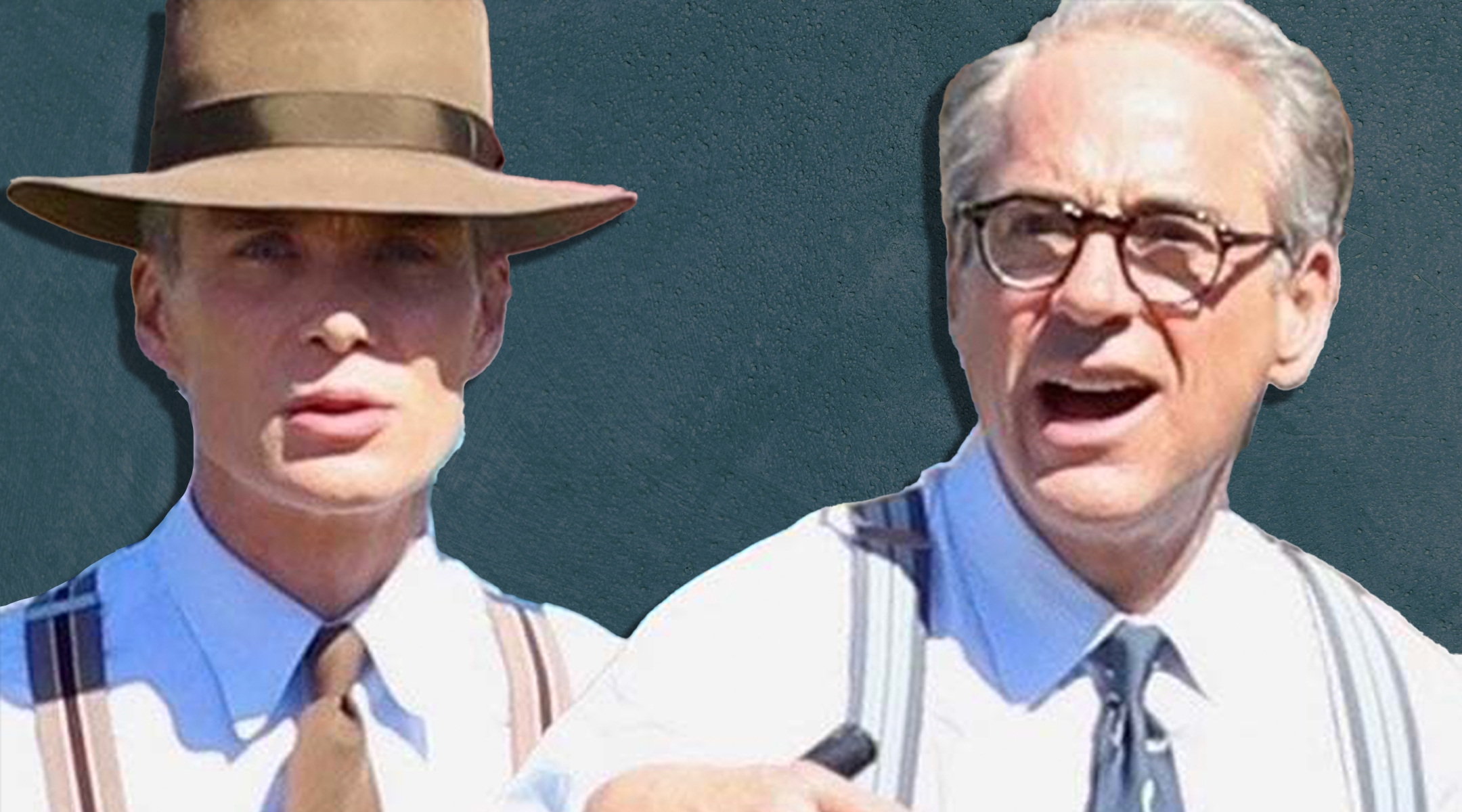
Cillian Murphy as Robert Oppenheimer, left, and Robert Downey Jr. as Lewis Strauss in the Christopher Nolan film “Oppenheimer.” (Universal Pictures)
After the war, Oppenheimer ends up in Princeton directing the famous Institute for Advanced Study and that’s going to bring him into the crosshairs of Lewis Strauss. Tell us who he is and how these two Jewish figures contrasted.
Three of Strauss’ four grandparents emigrated from Germany/Austria, probably in the 1830s, 1840s. Somebody ended up in Virginia and Strauss grew up in the South. His connection to Judaism is quite different from Oppenheimer’s. Strauss was a valedictorian of his high school and in his autobiography says that he was absolutely fascinated by physics. But the family had no money so rather than go to college Strauss became a traveling shoe salesman. And even though merchants he sold to would be closed on Sunday, he insisted on [also] taking Saturday off because of his Judaism, and he took the financial hit. He ended up volunteering to work for Herbert Hoover, the future Republican president, who was organizing European relief efforts after World War I. Hoover becomes a lifelong friend, advocate and supporter. Strauss managed to push Hoover — no friend to the Jews — to lodge a formal complaint when some Jews were slaughtered by the Poles.
He had a pretty meteoric rise. He gets connected to the Kuhn, Loeb investment firm, marries the daughter of one of the partners and he makes money hand over fist. But he stayed connected with his Judaism through all this, eventually becoming the president of Temple Emanu-El for 10 years from 1938 to 1948. So just like there are political differences between Oppenheimer and Strauss, there are religious differences: Oppenheimer grows up in the Felix Adler breakaway and Strauss is mainstream Reform Judaism.
Strauss was a trustee of the Institute for Advanced Studies when it hired Oppenheimer. What else came between the two men? I’ve read that Strauss was a proponent of the hydrogen bomb, and Robert Oppenheimer was hesitant because he felt the astronomically greater power of the H-bomb was not necessary.
The H-bomb was physicist Edward Teller’s idea — he called it “the super” — and Oppenheimer appropriately sidelined Teller at Los Alamos, saying “this is a distraction from what we’re trying to accomplish.”
The animosity between Strauss and Oppenheimer had probably several different dimensions. But I think Strauss also had to navigate being Jewish in an American society that didn’t totally embrace Jews, and I think it was somewhat of a threat to him to have somebody like Oppenheimer whose approach to dealing with his Judaism was to hide it, basically. Here’s Strauss, you know, president of Temple Emanu-El, he’s clearly not hiding that he’s Jewish, and he’s trying to survive and thrive in a Washington establishment that’s not so embracing of Judaism. So that was another dimension. I’d even read that Strauss was offended by Oppenheimer’s alleged marital infidelity.
The animosity also includes the fact that Oppenheimer could be mean. Generally, people who worked at the laboratory loved him, but he could also be mean, and he made Strauss feel like a fool in a public hearing in 1949 — sort of like, “You’re an amateur physicist. You don’t know what you’re talking about,” and that really cut to the quick.
Whatever the reason, Strauss is not a good enemy to have when he becomes a trustee of the Atomic Energy Commission. It’s Strauss who in 1953 told Oppenheimer that his security clearance had been suspended, and led Oppenheimer to request the hearing that led to his security clearance being revoked.
Strauss was appointed one of the five members of the original Atomic Energy Commission. The chair at the time was David Lilienthal, also Jewish by the way, and there’s a photograph of the five members of the Commission that’s absolutely perfect because there are four people on one side on the left, and one person sort of off by himself on the right — and it’s Strauss who’s off by himself. And there were apparently a few dozen votes of the Commission in its early years, mostly having to do with security matters, where the vote was four to one and Strauss was the lone dissenting voice. He was focused on security and was probably very anti-communist.
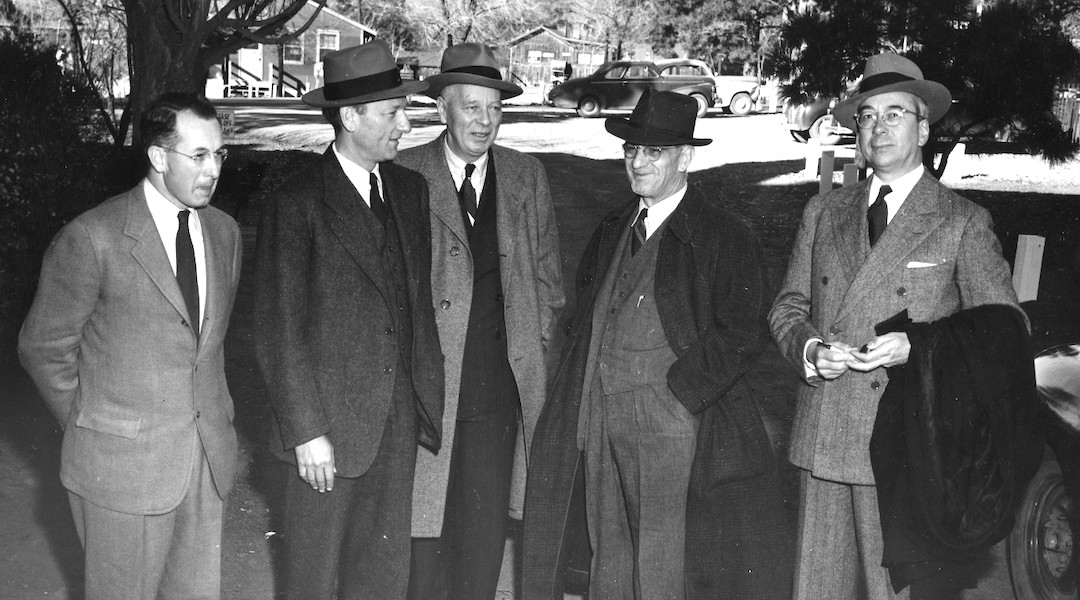
Lewis Strauss, far right, stands slightly apart from his colleagues on the Atomic Energy Commission, including chairman David Lilienthal, second from left, 1947. (Los Alamos National Laboratory)
I want to shift gears and talk about your background, and how a physicist becomes a rabbi.
I was a graduate student at the University of California, San Diego, and my thesis advisor sent me to Los Alamos for the summer of 1979 to learn a certain piece of physics. My connection to Judaism at that stage in my life was almost nil. I had done the classic sort of Conservative American Jewish upbringing of post-bar mitzvah alienation. When I came to Los Alamos I didn’t know a single person in town, so I thought I could go to the synagogue and meet some people. And because my training was reasonably thorough in the liturgy, I started leading some things at the synagogue while I was here.
Instead of going back to UC San Diego, I ended up continuing my graduate studies at the laboratory and completing my PhD while I was still here, and then got hired as a staff member at the laboratory. And all that time there was a rabbi who was coming up from Santa Fe to Los Alamos, and would teach an adult education class and I got interested. I had the arrogance of a newly minted PhD physicist that if you can learn physics, you can learn anything. So I started doing a lot of self-teaching in Judaism.
And what I discovered, which is my passion in the rabbinate, is that adult Judaism is not taught to kids because kids are kids. And most people reject Judaism like I did because they don’t know that Judaism is much richer than what most people reject. I spent my entire physics career here at the lab and in parallel, as I became more knowledgeable in Judaism, I came to know that I didn’t know anything. Then it turns out that there was a rabbi, Gershon Winkler, who moved to New Mexico and took me on as a private student, and that process led to my private ordination through him.
To pull the threads together, I’m curious how you as a physicist think about your responsibility for the uses of science, and how they mesh or clash with what you are learning in Torah.
I’ll steer your question slightly, if that’s okay. [The medieval Jewish philosopher] Maimonides says clearly that we’re given brains and the ability to do rational thought. Judaism is, it seems to me, inherently compatible with the idea of using your brain to understand how the world works, which is what physics is all about. Physics can help us see the beauty in the universe. And that beauty is part of what we’re given as a responsibility to appreciate in Judaism as well.
But science can also be applied for destructive purposes.
We are in a world that is not perfect. And, you know, there have been wars since time immemorial. Atomic weapons were used to end a war, and that was important. Like I said, my father to his dying day felt that his life was saved because of the atomic bomb, and you know, who’s to say that he was wrong?
In Los Alamos, how does the community process their legacy? Is it one of unmitigated pride or is it always leavened by regret about the destructive forces that were unleashed?
I think Oppenheimer is generally viewed very positively. What happened in Los Alamos was an important part of the history of the world. And it’s inspiring to be here at a place where, 80 years ago, there was basically nothing but a small boys’ school.
Swedish man abandons Torah-burning, saying it was a stunt: ‘We have to respect each other’
(JTA) — The Swedish man who applied for and received a permit to burn Hebrew and Christian Bibles near the Israeli embassy in Stockholm announced on Saturday that he had never planned to carry out the act.
Ahmad Alush told people who had assembled for the planned burning that he had applied for the permit to call attention to the harms and dangers of desecrating holy books, according to local media reports. His stunt was a response to a public burning of the Quran, the Muslim holy book, by a Christian Iraqi immigrant to Sweden earlier this month.
“I never thought I would burn any books. I’m a Muslim, we don’t burn,” Alush told the assembled crowd after throwing a lighter to the ground, according to SVT, a Swedish news outlet. “I want to show that we have to respect each other.”
Israeli and Jewish leaders — including Israeli prime minister Benjamin Netanyahu, U.S. antisemitism envoy Deborah Lipstadt and the World Jewish Congress — had condemned the planned burning, saying that it would inhibit the ability of Jews to practice without fear in Sweden. Swedish officials said the demonstration as planned was protected under the country’s freedom-of-speech laws.
Alexandria Ocasio-Cortez joins growing list of progressives who will skip Israeli president’s speech to Congress
(New York Jewish Week) – New York Rep. Alexandria Ocasio-Cortez joined fellow progressives Jamaal Bowman, Ilhan Omar and Cori Bush in saying she will skip Israeli President Isaac Herzog’s address to Congress next week.
The House member, who represents parts of the Bronx and Queens, told Jewish Insider her plans on Thursday. Missouri’s Cori Bush revealed her plans to Haaretz.
While the number of Congress members who have announced their plans to skip Herzog’s speech is far lower than the 58 who sat out of Israeli Prime Minister Netanyahu’s address to Congress in 2015, a handful of other progressive lawmakers critical of Israel — including Reps. Andre Carson of Indiana and Mark Pocan of Wisconsin — have yet to make up their minds.
Herzog is slated to speak to Congress on Wednesday, during a short visit to the White House that begins on Tuesday. Per the official statement from the White House, Herzog’s visit with President Joe Biden “will reaffirm the ironclad commitment of the United States to Israel’s security.”
The two leaders will also discuss “opportunities to deepen Israel’s regional integration and to create a more peaceful and prosperous Middle East”; “ways to advance equal measures of freedom, prosperity, and security for Palestinians and Israelis”; and “Russia’s deepening military relationship with Iran, and Iran’s destabilizing behavior in the region.”
Biden has criticized Israel’s plans to weaken its judiciary and said in March that he has no plans to invite Israeli Prime Minister Benjamin Netanyahu to the White House anytime soon. Herzog’s role as president is nonpartisan and largely ceremonial, but he has criticized the judiciary proposals, saying that they could spark “a civil war.”
Ocasio-Cortez has made a number of comments critical of Israel and its policies, including calling it an “apartheid state.” However, she has never vocalized support for the Boycott, Divest and Sanctions movement against Israel, and in 2021, she switched her vote from “no” to “present” during a Congressional vote to approve $1 billion in new U.S. funding for Israel’s Iron Dome missile defense system.
Anna Sokolow Way honors fierce Jewish dancer and choreographer
Editor’s note: This article is part of a new series, Sign Post, which explores street signs and other locations around the city that are named in honor of Jewish New Yorkers.
(New York Jewish Week) — For more than 50 years, Jewish dancer and choreographer Anna Sokolow would sit at the window of her apartment at 1 Christopher Street, drawing inspiration from the colorful parade of people walking by.
A pioneer of modern dance, Sokolow was known for exploring the pressing issues of her lifetime, including the Great Depression, the Holocaust, the anti-Vietnam War movement and the American counterculture of the 1960s. Her aim, according to Jewish Virtual Library, was to challenge her audiences to think deeply about the world around them,
On March 31, 2004 — four years after her death at age 90 — the Christopher Street block where she lived, between Greenwich Avenue and Sixth Avenue, received the name “Anna Sokolow Way.” Linda Diamond, a dancer, neighborhood fixture and a friend of Sokolow, led the effort to name the street. As part of the dedication ceremony, Diamond and her dance company performed several of Sokolow’s works at the Lucille Lortel Theater down the street, the New York Times reported that day.
Sokolow, whose most famous works include “Lyric Suite” (1953) and “Rooms” (1955), gained renown for creating work that commented on society. And yet, “She was very clear about not being political, but that she made dances about what she saw,” Samantha Geracht, the artistic director of the Sokolow Theatre/Dance Ensemble, told the New York Jewish Week. “So she would consider it humanity.”
Sitting at Greenwich Village’s Rosecrans Florist and Cafe, located just below Sokolow’s apartment, Geracht — who joined Sokolow’s dance company, then known as Players Project and later renamed Sokolow Theatre/Dance Ensemble — reflected on her mentor’s life and legacy. “Like Jewish tradition, modern dance — and particularly the way Sokolow coached modern dance — is an oral tradition,” said Geracht, emphasizing that Sokolow’s works must be passed down person-to-person.
Anna Sokolow was born in 1910 in Hartford, Connecticut to Russian Jewish immigrants, but soon after, her family moved to the Lower East Side, where she grew up. She first stepped into dancing shoes at Emmanuel Sisterhood of Personal Service, a Jewish social welfare organization run by women, and later, the Henry Street Settlement House, where she trained under modern dance legend Martha Graham, among others.
In the 1930s, Sokolow became affiliated with the “radical dance” movement, which helped establish choreography as a way to shed light on society’s problems. Her first big choreographed dance, “Anti-War Trilogy,” was performed at the 1933 First Anti-War Congress, and, according to Jewish Virtual Library, in the mid-1930s, Sokolow became the youngest American choreographer to lead her own professional dance group. The first showcase of her work took place at the Young Men’s Hebrew Association in 1936.
Eventually, Sokolow went on to choreograph Broadway shows, including 1955’s “Red Roses for Me,” for which she was nominated for a Tony award. She also staged work for the New York City Opera.
Sokolow also incorporated her Jewish identity into her work: In 1945, as the horrors of the Holocaust came to light, Sokolow choreographed her artistic response, “Kaddish,” in which she wrapped herself in tefillin and depicted scenes of mourning. “Dreams,” which premiered in 1961, was another dance exploration of the Holocaust.
In the 1950s, Sokolow was invited to travel to Israel to work with the Yemenite dance company Inbal Dance Theater, and continued her visits until the 1980s.
“Sokolow belongs to American Jewish culture, and people don’t know, and they should,” Geracht said.
To that end, Geracht and the Sokolow Theatre/Dance Ensemble have worked to incorporate Sokolow’s dances into synagogue programming and have even written a curriculum for religious school students to learn about Sokolow and her legacy. They also teach at various colleges, often partnering with Hillel and dance organizations.
As a choreographer, Sokolow knew exactly what she wanted from her dancers, and got just that. But at the same time, she was generous to her company. “She would personalize [her choreography] to the point of each person feeling complete ownership of what they were doing,” Geracht said. “I think that was a gift to the dancer and a gift to the audiences.”
Geracht reflected how Sokolow could often be heard saying: “It’s not that I don’t love you, it’s that I love dance more.”
Upon her death in 2000, the Jewish Telegraphic Agency wrote that Sokolow was known for embracing “pessimistic themes” in her work. “I’m not neurotic,” a JTA News Bulletin quoted Sokolow as saying. “But I don’t have that happy philosophy, because what the hell is there to be happy about?”
Her stubbornness when it came to dance translated to other parts of her life as well. Geracht says she can’t recall a time — even when the choreographer was well into her 80s — when Sokolow would take the elevator. Sokolow was notorious for refusing to take a cab or the subway. Walking was another way for Sokolow to people watch, and everyone talked to her.
“Every storekeeper knew her. The homeless people knew her. They all knew who she was,” Geracht said. “And so she was a fixture of the neighborhood by nature of her personality and by nature of being a people-watcher.”
“She was a force to be reckoned with,” she added.
To find out about upcoming performances and learn more about Anna Sokolow’s dance legacy, visit SokolowTheatreDance.org
The Jewish Sport Report: 18 Jewish players in the MLB is a likely — and fitting — record
This article was sent as a newsletter. Sign up for our weekly Jewish sports newsletter here.
Good afternoon, Jewish sports fans!
Few families had as exciting a week as the Gelofs did. On Sunday, Jake Gelof, a power-hitting third baseman from the University of Virginia, was drafted 60th overall by the Los Angeles Dodgers in the MLB Draft. (More on him and the other Jewish draftees below).
Then on Wednesday, older brother Zack Gelof, another UVA alum who was drafted (also 60th overall!) by the Oakland Athletics in 2021, received the news every young ballplayer dreams of: he’s being promoted to the big league club.
Zack, who played for Team Israel in the World Baseball Classic earlier this year, will become the 18th Jewish player to appear in the MLB this year — a likely record.
What a way to start the second half of the season! Mazel tov to the Gelof fam.
Meet Daniel Edelman, rising MLS superstar

At just 20, Jewish player Daniel Edelman is a rising star for the New York Red Bulls. (Courtesy New York Red Bulls)
New York Red Bulls midfielder Daniel Edelman is only 20 years old, but his star has already risen considerably in the past year.
Edelman won the Red Bulls’ Newcomer of the Year award last season. Then, as captain of the under-20 U.S. Men’s National Team, he led the team to the quarterfinals at the under-20 World Cup in Argentina in May. He was also selected as one of the New York Jewish Week’s “36 to Watch” for 2023.
This past weekend, Edelman received an honor befit for a hero: the team held a Marvel Night at Red Bull Arena and gave away an Edelman bobblehead inspired by a “Guardians of the Galaxy” character.
“It’s really exciting,” Edelman told my colleague Lisa Keys. “It’s my second season with the team, and to have a bobblehead made of me is pretty cool. This is a team I grew up looking up to, admiring all the players.”
Read our profile of the soccer star here.
Halftime report
SOLOMON’S NEW KINGDOM. Israeli soccer phenom Manor Solomon has signed a five-year contract with Premier League powerhouse Tottenham, a club with a rich (and at times controversial) Jewish history. The team’s fanbase, which has historically included many Jews, has called itself the “Yid army.”
ROAD TEAM. A team of 14 baseball players from the North Israel Little League are traveling to Kutno, Poland, today to represent Israel in the Little League World Series qualifiers. This is Israel’s first appearance in the tournament. “When I look at this team, I see what Israel should be,” team manager David Weiss said in a press release.
UNBOXING. The Los Angeles Times announced this week that it would stop posting box scores in its sports section — a change that upset many Jewish fans who rely on the paper for sports news on Shabbat. The Forward has the story. (Plus, The New York Times announced it would shutter its sports section and instead focus on its coverage in The Athletic.)
HOME FIELD ADVANTAGE. In the pantheon of sports executives, Adam Neuman is a rising star. After a stint as chief of staff for strategy and operations at the Big Ten Conference, Neuman is returning to his hometown to serve in a similar role with the Baltimore Ravens.
FULL COURT PRESS. New Phoenix Suns owner Mat Ishbia, who purchased the team late last year, has already had an impact in the organization. According to ESPN, Ishbia “has let it be known how he is going to run the Suns: aggressively and from the front.”
Meet the 2023 Jewish MLB Draft class

Jake Gelof, left, and Zach Levenson, right, headline the group of Jewish players drafted into MLB in 2023. (Getty Images)
Over 600 baseball players were drafted across 20 rounds of the MLB Draft this week — and five of them are Jewish.
There’s the aforementioned Jake Gelof, who just set the all-time home run record at UVA.
Then there’s outfielder Zach Levenson (158th), who was ranked 204th in MLB’s prospect rankings, plus RJ Schreck (277th), Ben Simon (396th) and Will King (609th).
Meet all five draftees right here.
Jews in sports to watch this weekend
⚾️ IN BASEBALL…
Dean Kremer takes the mound for the Baltimore Orioles against the Miami Marlins tonight at 7:05 p.m. ET. Jake Bird and the Colorado Rockies face Harrison Bader and the New York Yankees tonight at 8:40 p.m. ET. Zack Gelof is likely to make his major league debut as his Oakland A’s host the Minnesota Twins tonight at 9:40 p.m. ET.
⚽️ IN SOCCER…
Daniel Edelman and the NY Red Bulls host Real Salt Lake tomorrow at 9:30 p.m. ET. Manor Solomon and his new club Tottenham begin their preseason friendly matches Tuesday at 6 a.m. ET against West Ham.
⛳️ IN GOLF…
Max Homa is across the pond this weekend for the Scottish Open, while Ben Silverman is competing at The Ascendant tournament in Colorado.
Highlights from the JCC Maccabi Games

The victorious under-17 boys soccer team at the JCC Maccabi Games (Courtesy of JCC Association)
The JCC Maccabi Games wrapped up this week, where 74 delegations of more than 1,000 Jewish teens from 10 countries competed for four days in Israel.
A mixed team of athletes from Morocco, Ukraine, Israel, Washington and Indiana won a gold medal in under-17 boys soccer — despite speaking four different languages. In swimming, a pair of Ukrainian teens won gold. And now that the competition is over, teens will spend time touring Israel on an educational program.
Congrats to all the medal winners!
Jewish camp alums cheer ‘Theater Camp,’ Ben Platt movie shot at former Kutz Camp
(JTA) — In January, 25 alumni of the Union for Reform Judaism’s Kutz Camp gathered on their former campus. Although the historic summer camp known for fostering Reform leadership and leaving a mark on modern Jewish music had shuttered in 2019, the alumni were back for a preview screening of “Theater Camp,” a comedy film from Jewish co-creators Ben Platt, Molly Gordon and Noah Galvin filmed on Kutz Camp’s grounds in Warwick, New York.
The mockumentary centers on a fictional upstate musical arts camp, AdirondACTS, that is striving to fend off foreclosure after its founder Joan (Amy Sedaris) falls into a strobe-light-induced seizure at a middle school production of “Bye Bye Birdie.” (Joan is intended to be the subject of the documentary, but filming soon turns to a cast of zealous teachers and campers who forge ahead with an original musical about her legacy entitled “Joan, Still.”)
Platt and Gordon star as codependent best friends and self-serious instructors, alongside Galvin as an artistically repressed “third-generation stage manager” and Jimmy Tatro as Joan’s son, an earnest finance bro humorously trying to balance her accounts. Created by four former theater kids (Platt, Gordon and Galvin wrote the screenplay while Nick Lieberman co-directed with Gordon), “Theater Camp” hopes to resonate beyond its satirized social niche when it premieres on Friday.
Although AdirondACTS is a secular arts camp, the film is peppered with Jewish references — a previous summer’s musical production was called “A Hanukkah Divorce,” and one auditioning 11-year-old chooses camp over sitting shiva for her cousin. The closing performance of “Joan, Still” reveals that Joan was born to an Eastern European Jewish family and immigrated as a young girl.
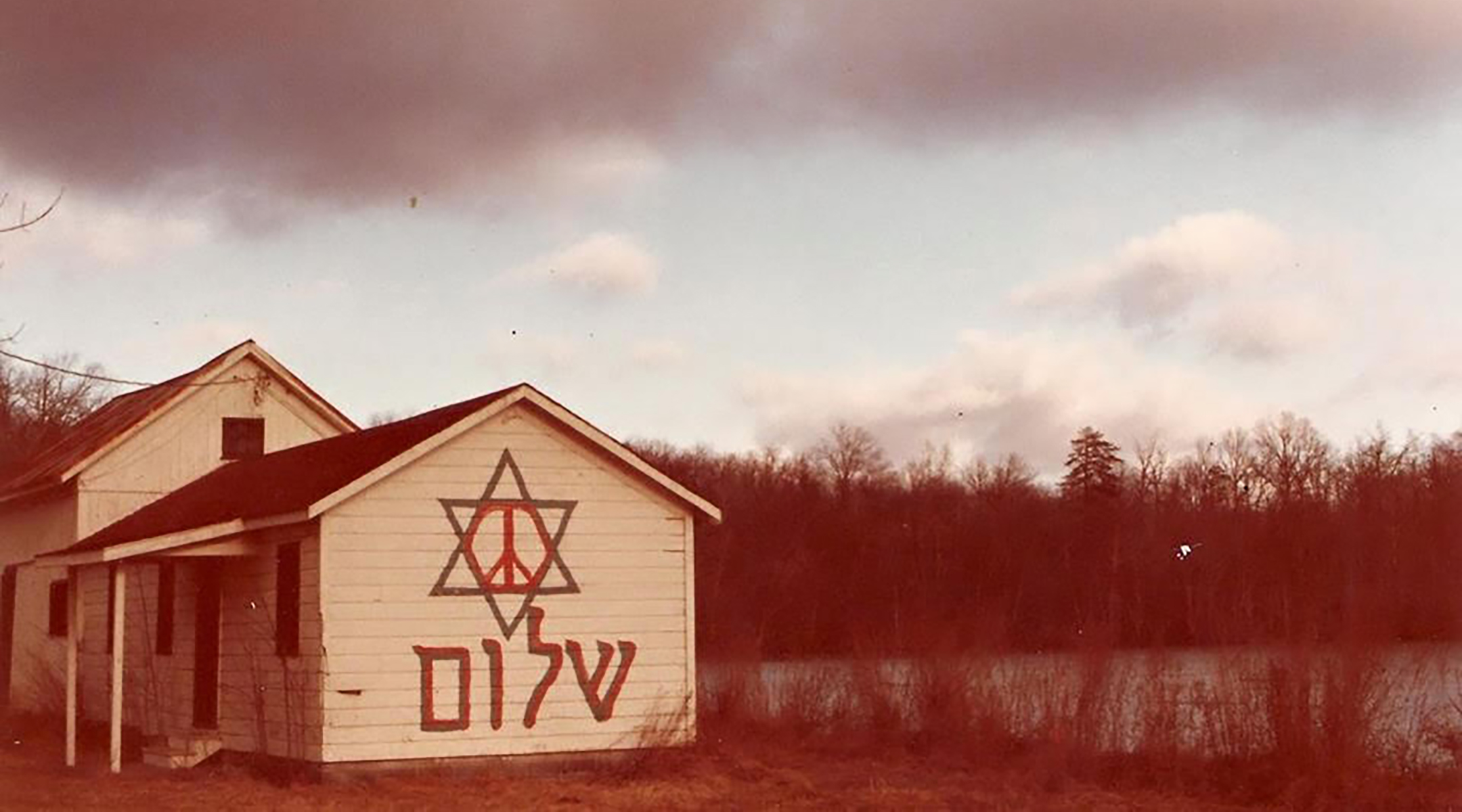
An undated view of a Kutz Camp bunk. (Jeff Klepper)
Kutz Camp leader Andrew Keene, who rented the site for a weekend in January and organized the “Theater Camp” viewing for alums, said they were moved to watch the campgrounds come back to life. Keene was involved with Kutz for 10 years, first as a participant, then as a staffer and finally as vice chair by the time the camp closed, squeezed by competition from other programs and declining attendance. Kutz was bought by the Town of Warwick and repurposed as a public recreational center.
“It really hit home for us,” Keene told the Jewish Telegraphic Agency. “Even though it wasn’t about a Jewish camp, the themes of inclusion and belonging really resonated.”
Platt and Gordon took inspiration from their own experiences in youth theater — their collaboration dates back to the Adderley School for the Performing Arts, where they met at 4 and 5 years old. But parts of the film also drew from Platt’s summers at a California branch of Camp Ramah, a prominent network of Conservative Jewish camps.
“Molly went to Stagedoor and Noah and Nick went to youth theater camp and we did a youth theater program together, but in terms of my sleepaway summer camp experience it was all at a Jewish summer camp,” Platt said in an interview with Letterboxd. “We have this whole conceit about teachers performing a night time performance for the kids that was ripped directly from my camp experience.”
Like the fictional AdirondACTS camp, Kutz was an incubator of artistic talent. The camp was founded in 1965 and became known as a birthplace of modern Jewish folk music after Debbie Friedman, whose songs revolutionized Jewish prayer and continue to be sung in synagogues nationwide, served as its song leader in 1969.
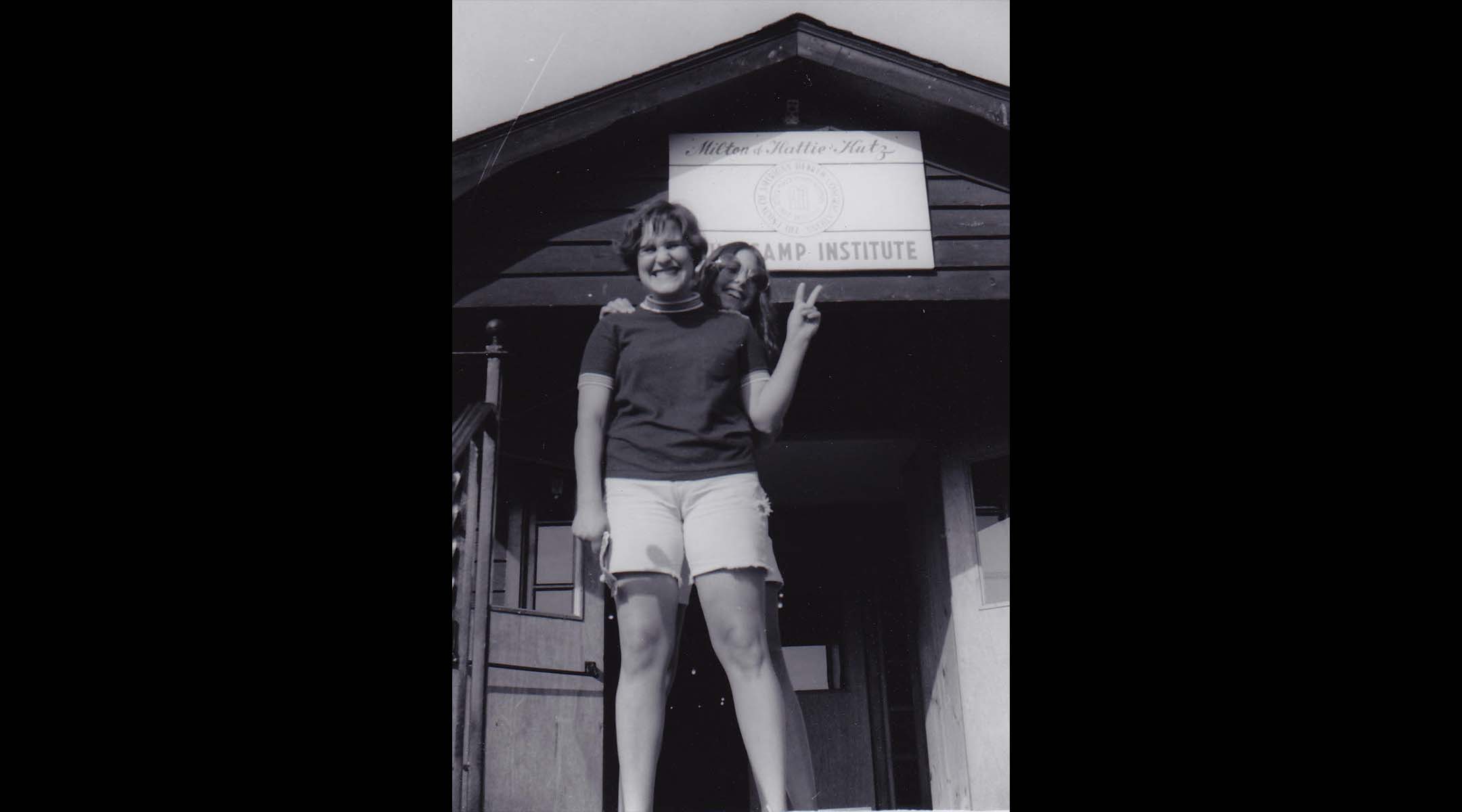
Debbie Friedman makes a peace sign at Kutz Camp. Her songs would go on to be sung in Reform congregations across the country. (Jeff Klepper)
“I would honestly be surprised if there was another movie written about summer camp, especially a theater summer camp, that did not come from Jewish writers and artists,” said Keene. “It is such an embedded narrative in the American Jewish experience.”
The Jewish summer camp has shaped American Jewish identities for over a century, said Sandra Fox, who teaches at New York University and wrote “The Jews of Summer: Summer Camp and Jewish Culture in Postwar America.” In the 1920s, when Jews were largely concentrated in cities, they started going to camp amid a broader social movement concerned with how industrialization was affecting children’s physical and mental health.
But it was after World War II that camp took on a vital significance for American Jewish leadership, said Fox. Jews were moving to the suburbs and assimilating into a white middle class, while the Holocaust had left them anxious about the future of their culture and religion.
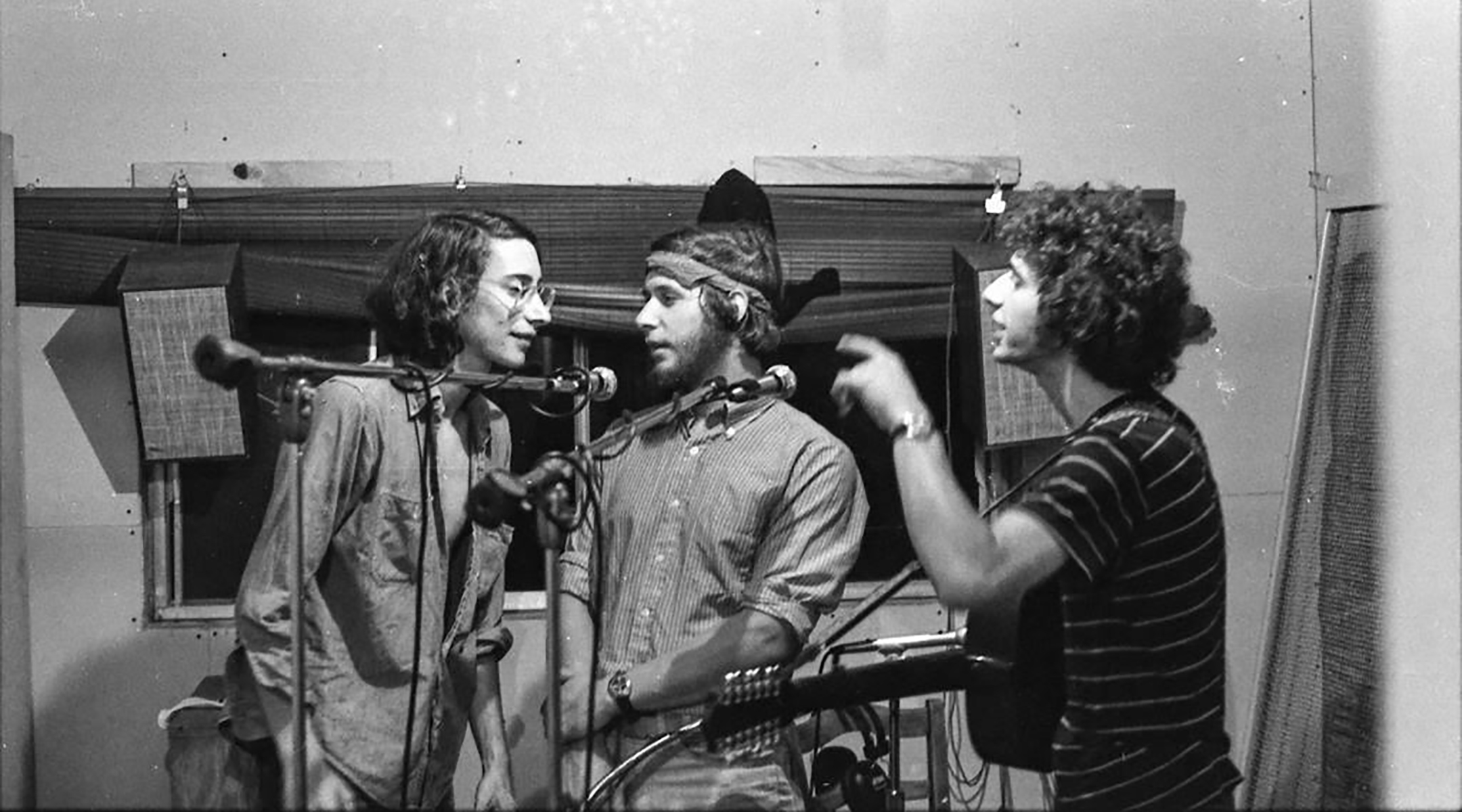
A trio of counselors get musical at Kutz Camp. (Courtesy of Jeff Klepper)
“Most American Jewish kids went to public school, where they socialized with gentiles,” said Fox. “So Jewish camps were a place where ethnic cohesion could still continue.”
According to a 2020 Pew Research Center study, four in 10 Jewish Americans attended a summer camp with Jewish content. The camps became critical to educating future generations of Jewish leadership.
Rabbi Lisa Silverstein Tzur, the last chair of Kutz, credits the camp with the formation of her Jewish identity. Tzur grew up in a secular household and first attended Kutz in 1983, hoping to learn about crafting Jewish music.
“In actuality, I was able to not only explore my musicality, but to explore my Jewish identity in a way that was profound,” Tzur told the Jewish Telegraphic Agency. “My summer at Kutz in 1983 was the single most influential experience that led me to the career path that I chose. Had I not gone to Kutz, I would not have become a rabbi.”
Tzur was gratified that the makers of “Theater Camp” were former camp kids themselves.
“I hope that when they walked into that place — knowing even just a little bit about the history of the camp — I hope that they felt as at home there as they did in their summer camps when they grew up,” she said.
Broadway had a very Jewish year, but there is more to the Jewish story than antisemitism and the Holocaust
(JTA) — Broadway gave out its Tony Awards last month, and as I kept whispering to my wife, it was “a big night for the Jews.”
“Leopoldstadt,” Tom Stoppard’s Holocaust drama, won best play. “Parade,” about the lynching of a Jewish man in the American South, won best musical revival. Miriam Silverman (“The Sign in Sydney Brustein’s Window”) and Brandon Uranowitz (“Leopoldstadt”) won for signature Jewish roles, and Alfred Uhry, who wrote the book for “Parade,” spoke while wearing a two-inch diamond Magen David lapel pin.
It was, in fact, a very prominent season for Jews on Broadway stages and beyond. “The Sign in Sydney Brustein’s Window,” Lorraine Hansberry’s second play — with a white, Jewish protagonist — arrived in a star-studded Broadway bow. “Prayer for the French Republic” at Manhattan Theatre Club — an examination of antisemitism in France — marked a massive turn in playwright Josh Harmon’s Jewish journey (and will return to Broadway next season).
The Atlantic’s Yair Rosenberg raved over Edward Einhorn’s “Shylock and the Shakespeareans,” a reworking of Shakespeare’s “Merchant of Venice,” and Second Stage presented “Camp Seigfried,” a different angle on German fascism. In California, the La Jolla Playhouse tried out “Lempika,” a musical about the notorious Jewish artist Tamara de Lempicka, who fled Europe for the United States in 1939.
You might see a thesis at work in producing these shows — most of which spotlight Nazis, antisemitism or the Holocaust — right now: They urge audiences to remember and learn from the past in order to prevent future atrocities, at a time when antisemitism is on the rise (or at least outward manifestations of the ancient hatred; one could argue it has been there all along).
There’s lots to recommend this idea. A history forgotten is a history that will repeat. Representation matters. Giving Jews the moral victory (if not the narrative one) strengthens our resolve. Great artistry in the service of big ideas is a win for everyone.
And let’s not leave out the performances themselves. Uranowitz in particular was brilliant and gave a moving Tony speech honoring his ancestors who were murdered by the Nazis in Poland.
However, I can’t help but admit to some skepticism. I’m drawn by thinkers like Dara Horn, author of “People Love Dead Jews,” who ask, “By revisiting the history of raging antisemitism, are we just giving violent extremists a to-do list for the future?”

“A Moving Picture” by Jennie Berman Eng, presented at the Marlene Meyerson JCC Manhattan, Dec. 1, 2022. (Basil Rodericks)
And it’s definitely debatable whether reliving trauma is mentally healthy for those affected. (My wife, a daughter of both a Holocaust and Tree of Life shooting survivor, gets significantly triggered by poking at these wounds.)
But more important is that today’s Jewish life — even the parts necessarily focused on antisemitism — is radically different than it was 50 or 75 or 500 years ago. Even with the challenges and outright discrimination, the Jewish community today (here and abroad) is more diverse, more free and more complex than at arguably any time in history.
So I’d like to humbly offer some alternatives for producers and artistic directors who want Jewish representation on their stages. As the artistic director of the Jewish Plays Project, a development house for 21st-century Jewish theater based in New York and working around the country, I have the unique pleasure to be able to point to the plays written in just the last few years that can change the paradigm right now.
I’d like to encourage folks to think about Jewish joy. See Audrey Lang’s amazing character Librarian of the Jewish Soul in her play “Birdie & Cait and the Book of Life” or the Adon Olam sequence at the end of Mark Leiren Young’s “Bar Mitzvah Boy.”
Think about Jewish ethics. Beth Kander’s “Return” puts todays’ scientific breakthroughs and faith right up against each other; Marshall Botvinick’s poetic “To Reach Across a River” gives us an Orthodox woman refusing to leave her faith when she adopts a bi-racial daughter; and Cindy Cooper’s “I Was a Stranger Too” directly advocates for immigrants through a Jewish lens.
Stage Jewish diversity. Ali Viterbi’s “In Every Generation,” Molly Olis-Krost’s “What We Found” and EllaRose Chary’s “The Wrong Question” show us parts of the Jewish world — Jews of Color and queer Jews, among other mixed and modern identities — that haven’t made it to the stage much. (And we’re all waiting with baited breath for the results of Expanding the Canon, Theater J’s significant commissioning program for Jewish artists of Color.)
Talk about Israel/Palestine without blowing the roof of the joint. Seth Rozin’s “Settlements” is nuanced and compelling and real. Alexa Derman’s hilarious and satirical cri-de-coeur “Zionista Rising” — which just won the JPP’s National Playwriting Contest —brings sharp, contemporary humor to a difficult conversation.
And if you feel you have to talk about the Holocaust and Shylock — and sometimes you do — do it with a new and vital eye. Jenny Berman Eng’s “A Moving Picture” features a cast of three Jews of Color, one Black doctoral candidate and a white student working out how to make a 100% true Holocaust film, and Eric Marlin’s “there will come a time for vengeance” mashes up Shakespeare and his contemporary Christopher Marlowe with theatrical flair.
The point is, it’s a big Jewish world out there — exciting and current and diverse. The hundreds of Jewish Plays Project artists and audience members who are part of our ongoing experiment in artistic democracy are hungry to see that life show up at theaters all over the country.
If we can do that, we might see a Tony Awards (and Obies and Jeffs and Barrymores and more) that both celebrates brilliant work and moves the Jewish conversation forward — not by being anti-antisemitism, but by being truly pro-Jewish.
That would really be a big night for the Jews.
‘Funny Girl’ national tour casts non-Jewish actor as Fanny Brice, reigniting ‘Jewface’ criticism
(JTA) — The announcement this week that Katerina McCrimmon would star as Fanny Brice in the national tour of “Funny Girl,” the Broadway musical about a trailblazing Jewish comedian, has ignited criticism from some Jewish actors who say the role should be played only by someone who identifies as Jewish.
The casting, announced on Tuesday, is a breakout role for McCrimmon, who previously appeared briefly on Broadway in Tennessee Williams’ “The Rose Tattoo” but has mostly done smaller productions.
But it has disappointed some Jewish performers and their allies in the theater community who knew that the production had advertised itself as “specifically seeking actors of Jewish heritage.”
Jennifer Apple, one of the first actors to discuss the decision on social media, told the Jewish Telegraphic Agency that because Jewishness was central to Brice, a pioneering early 20th-century vaudevillian, it should be for anyone playing her as well.
“Fanny Brice was a real human being,” said Apple, who also auditioned for the role of Brice and appeared in the national tour of “The Band’s Visit,” about an Egyptian police band’s accidental stay in an Israeli town. “She was a Jewish icon. She was a heroine. She in and of herself paved the way for performers like myself to be able to have a career. If it wasn’t for her, and her chutzpah, many of us Jewish women specifically wouldn’t be able to be performers. So it’s integral to this role, specifically.”
Someone can have Jewish heritage without embracing a Jewish identity — just ask the actor Lea Michele, who replaced Jewish actor Beanie Feldstein as Brice in the recent Broadway revival of “Funny Girl.” Michele’s father is a Sephardic Jew, but she was raised as a Catholic and said she does not identify as Jewish. (For six seasons on the hit television show “Glee,” Michele played a Jewish character, Rachel Berry, who was set on one day portraying Fanny Brice.)
But none of the coverage of McCrimmon’s casting in arts outlets has suggested any personal connection to the Brice character’s Jewish identity, and in the show’s materials, she identifies as “a proud Cuban-American from Miami.” She did not respond to a request for comment.
“I have no doubt that Katerina is freaking terrific and … that she is more than capable of leading a nat’l tour,” Samantha Massell, an actor who appeared in the revival of “Fiddler on the Roof” on Broadway, posted on Instagram after the casting announcement. “But if you consider yourself an advocate for representation in casting and you’re AOK with this (or celebrating it), you need to check yourself.”
The casting adds to an ongoing debate over identity and performance. Some argue that actors should be able to play any role, regardless of their background. But the idea that at least some roles should be reserved for actors whose identities overlap with their characters’ has gained steam in recent years — opening the door for criticism when people who are not Jewish are cast as Jewish characters. (Helen Mirren, who is not Jewish but is playing the Israeli stateswoman Golda Meir in the upcoming film “Golda,” is among those who say they “adhere to both camps.”)
Some have criticized the casting of non-Jewish actors in Jewish roles as “Jewface.” The Jewish comedian Sarah Silverman, for example, lambasted the casting of Kathryn Hahn as Joan Rivers in a biopic that was ultimately scrapped; another frequent subject of criticism has been Rachel Brosnahan as the fictional Jewish comedian Midge Maisel on “The Marvelous Mrs. Maisel.”
The real-life Brice got her start in the 1910s headlining Florenz Ziegfeld’s revue, the “Ziegfeld Follies.” The 1964 musical and subsequent film “Funny Girl,” both starring Barbra Streisand, chronicle Brice’s rise to fame while she grapples with her own identity as a Jewish woman — including the shape of her nose, the cadence of her voice and the pacing of her humor.
“If there is something in the piece that when portrayed by somebody of a different identity could potentially be viewed as perpetuating a stereotype or veer into the land of cultural appropriation, you’ve made the wrong casting decision,” said Ari Axelrod, an actor and producer who organized a Broadway gathering in response to a neo-Nazi protest outside the first preview of “Parade,” the show about a 1915 antisemitic lynching, in which the main character is played by the Jewish actor Ben Platt.
Critics of the casting choice say specific lyrics and visual gags just don’t work as well when they are performed by people who do not have specific Jewish lived experiences because they are or can be offensive.
The song, “If a Girl isn’t Pretty,” for example, contains the lyric, “Is a nose with deviation such a crime against the nation?” referring to Brice’s own body image issues, which she partially resolved with one of the earliest rhinoplasties in the United States.
And in the song “Rat-Tat-Tat-Tat,” Brice’s character plays the Jewish caricature “Private Schwartz from Rockaway,” who wears a harness outfitted with two suggestively placed bagels and sings in an exaggerated Eastern European accent about how his “bagels gave a spin, oy, oy.”
“The content of this show is specifically about how she was not considered a pretty Jewish woman, that she had to change her name and change her looks to ‘fit in,’ that she had to assimilate because of her Jewish identity,” Apple said. “To have somebody not be Jewish and do that could perpetuate stereotypes.”
Axelrod and Apple both pointed to the casting of actor Bradley Cooper as American Jewish composer Leonard Bernstein in the upcoming Netflix film “Maestro” as another example of a “Jewface” gaffe. (Early stills of Cooper wearing a prosthetic nose for the role reignited the debate; Silverman is set to appear in the film.)
The casting decision for the tour follows a 15-month Broadway run for “Funny Girl.” Beginning in April 2022, Feldstein starred as Fanny Brice in the revival, bringing a childhood dream of hers to life. (Feldstein’s 3rd birthday party was “Funny Girl”-themed.)
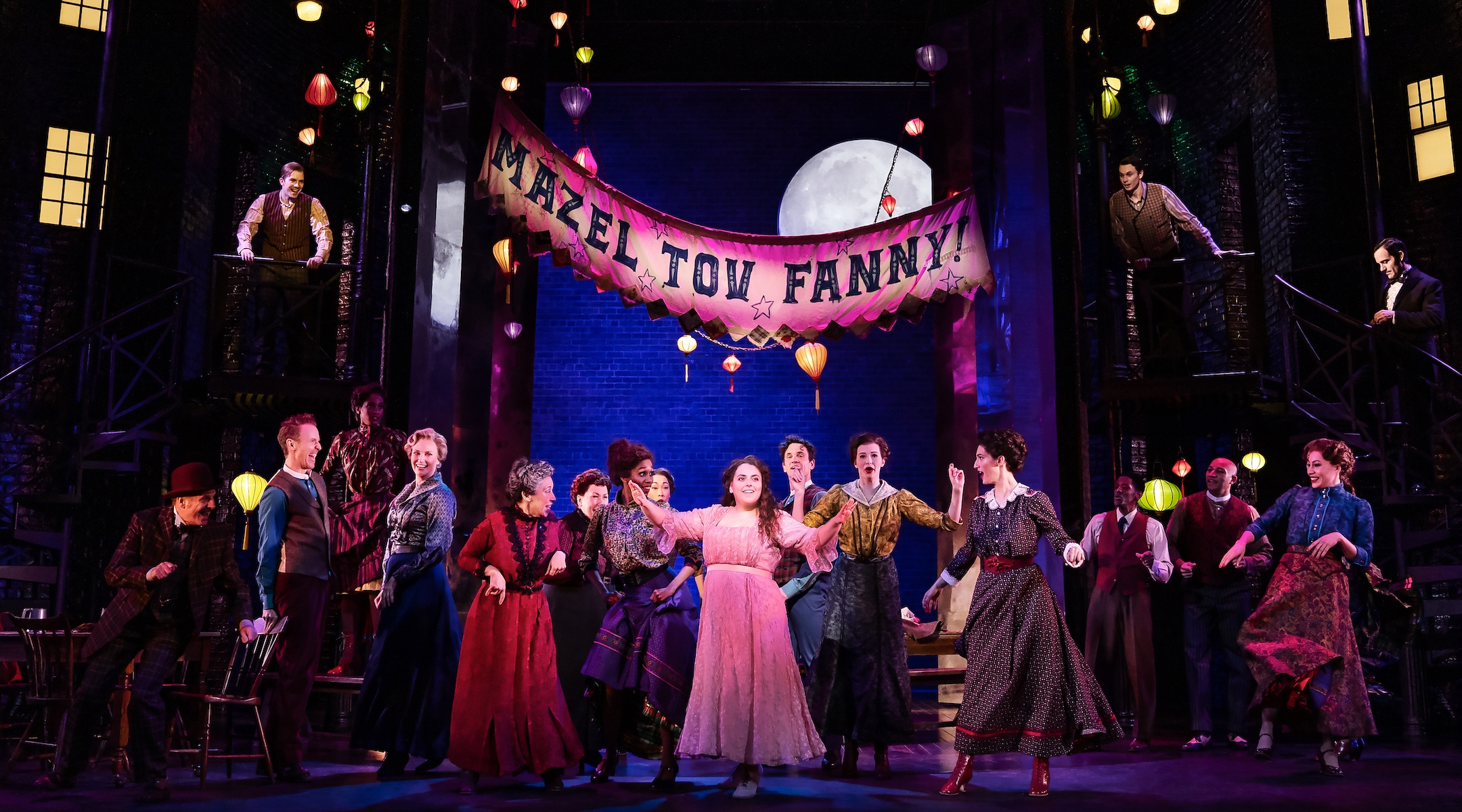
Beanie Feldstein, center, stars as Fanny Brice in the Broadway revival of “Funny Girl.” (Matthew Murphy)
“I truly believe that any Jewish woman who wants to be funny and perform and sing owes something to Fanny Brice,” she told the New York Jewish Week last year.
But after three months, the production announced that Michele would replace Feldstein — after a one-month performance by Jewish actor Julie Benko.
Under the laws of the Equal Employment Opportunity Commission, it is illegal for a workplace to discriminate against an applicant or employee’s race, religion, sex or gender identity, national origin, age or disability. But the law allows employers to select for aspects of personal appearance if they are essential for fulfilling the requirements of the job — a leniency that opens the door to casting Black actors as Black characters, for example.
There are legal ways to stack the deck in favor of filling roles with actors of certain backgrounds, such as by encouraging people who hold specific identities to audition, or by encouraging others to choose not to.
Massell revealed in an Instagram story Thursday that when the casting directors of the musical “Double Helix,” which tells the story of the discovery of the structure of DNA, were auditioning for the other two Jewish roles (Massell plays the lead role of Rosalind Franklin), they asked people who do not identify as Jewish to “please pass” on auditioning.
“This feels like such a great actionable step for all of these types of roles that are specifically tied to an ethnic identity,” she said.
Those who are challenging the Brice casting on the national tour say there is room for actors to play characters unlike themselves. Apple — who said she has twice been one of just two Jews cast in professional productions of “Fiddler” — says it’s a “slippery slope” to argue that actors must only play their own identity.
“I don’t like that. I don’t subscribe to that. That’s not why I’m an actor,” she said. “It really just comes down to the integrity of the role and the story. And this one is literally about her Jewish identity. She was a Jewish icon.”
Who made the decision to depart from the character breakdown suggestion is not clear. Sonia Friedman Productions and NETworks Presentations, which are producing the tour that is set to launch in Providence, Rhode Island, this fall, did not respond to requests for comment.
“I do know that for this to have happened, a lot of people had to say yes,” said Axelrod.
He said that even though he disagrees with the casting decision, he believes it could have positive dividends for storytelling about Jews.
“Katerina has an incredible opportunity to use this moment to educate herself and empathize with Fanny’s story, but also the story of Jews today,” he said. “If we can’t change the casting decision — and I don’t necessarily think we should, it’s not up to me — we can leverage the moment as an opportunity for empathy and education.”
Young Jews are demanding action on climate change
This article was produced as part of JTA’s Teen Journalism Fellowship, a program that works with Jewish teens around the world to report on issues that affect their lives.
(JTA) — On an unusually warm February day, approximately 200 Jews gathered at the Hebrew Educational Alliance in Denver, Colorado for the inaugural Colorado Jewish Climate Summit, which coincided with Tu Bishvat, the new year of the trees.
Among the attendees were about 20 teens, who filed into the sanctuary, past tables stacked with brochures on sustainability and vibrant tapestries portraying Torah stories. They clustered into wooden pews, discussing the climate workshops they would attend — or lead.
“In the Jewish community, we talk about being collective in our efforts. And climate change is the same way — it’s not what one of us does, it’s what many of us do,” said Noah Shurz, a 16-year-old from Denver who helped plan the summit.
As the climate crisis and the global response to it intensifies, many Jewish teens are utilizing the intersections of Jewish and environmentalist teachings as impetus for activism. Through participating in groups like Jewish Youth Climate Movement, Dayenu and Jewish Climate Action Network, teens are strengthening their connection to Judaism and deepening their sense of community. Values like Tzedek Tzedek Tirdof (“justice, justice you shall pursue”), Tikkun Olam (“repairing the world”) and L’Dor V’Dor (“from generation to generation”) fuel their activism. These activists bring a unique perspective to the movement, combining the fervor of young changemakers with the tradition of the Jewish people.

Event attendees sign up for lunch orders from the sustainable food trucks provided during the Colorado Jewish Climate Summit. (Courtesy of Colorado Jewish Climate Action).
“My Judaism and my desire to fight against climate change go hand in hand,” said Rivka Schafer, a Modern Orthodox 18-year-old from Teaneck, New Jersey who uses they/them pronouns. In their role as co-director for Jewish Youth Climate Movement, a youth organization founded in 2019 that has about 450 members, Schafer acts as the bridge between youth leaders and adult staff.
Schafer described participating in climate action as almost a religious obligation. “When I go into nature, I feel inherently connected to God,” said Schafer. “To see that loss of our natural world to me resembles a loss of spirituality as well.”
Schafer became a climate activist at age 12 after seeing bleached coral reefs firsthand during an underwater dive. “For the first time, it hit me, the destruction we are causing our world,” they said. “I decided that if the government wasn’t doing anything to fix the world, and if the adults weren’t doing enough, then it was up to me to bear that responsibility of healing our planet.”
Schafer’s co-director, Amber Marcus-Blank, 18, from Sharon, Massachusetts, shares this connection to the natural world. “There is a very similar feeling that I get when I’m reading Jewish prayers and when I’m in nature,” said Marcus-Blank.
In the past, Jewish Youth Climate Movement has pushed for banks to divest from fossil fuels, participated in and led climate protests and sent youth representatives to the U.N COP27 climate conference. More recently, as smoke from wildfires engulfed the eastern U.S, causing alarmingly poor air quality, JYCM teens connected the Biblical concept of neshama (both “breath” and “soul”) to the climate fight. The organization challenged their Instagram followers to “fight to protect the sanctity of our breath and the right for all communities to breathe safe and clean air,” suggesting actions like calling representatives to pass climate legislation like the NY HEAT Act.
The organization works with local Jewish institutions to create change within Jewish communities. Institutions “can look at implementing recycling/compost…can encourage transit usage by trying to get a bus stop next to them, or having bike parking and reducing car space: things to get people to see what they could also do in their household… and advocating for [climate action] bills,” said Shurz. JYCM teens lead sustainability trainings at Jewish institutions, build resources, run the social media accounts, and organize demonstrations; a few adult staff handle behind the scenes work.
Jewish activists use similar tactics to other groups — such as divestment campaigns or changes to unsustainable infrastructure — but their actions are by, about, and for Jews. Groups like JYCM make helping synagogues or day schools become more sustainable, a top priority.
For example, many synagogues, with assistance from Adamah (previously Hazon), are moving towards greener energy. The organization provides energy audits, educational resources, and institutional partnerships via their Jewish Climate Leadership Coalition (with more than 30 institutions across the country). Youth activists help educate Jewish communities as to the necessity of the program.
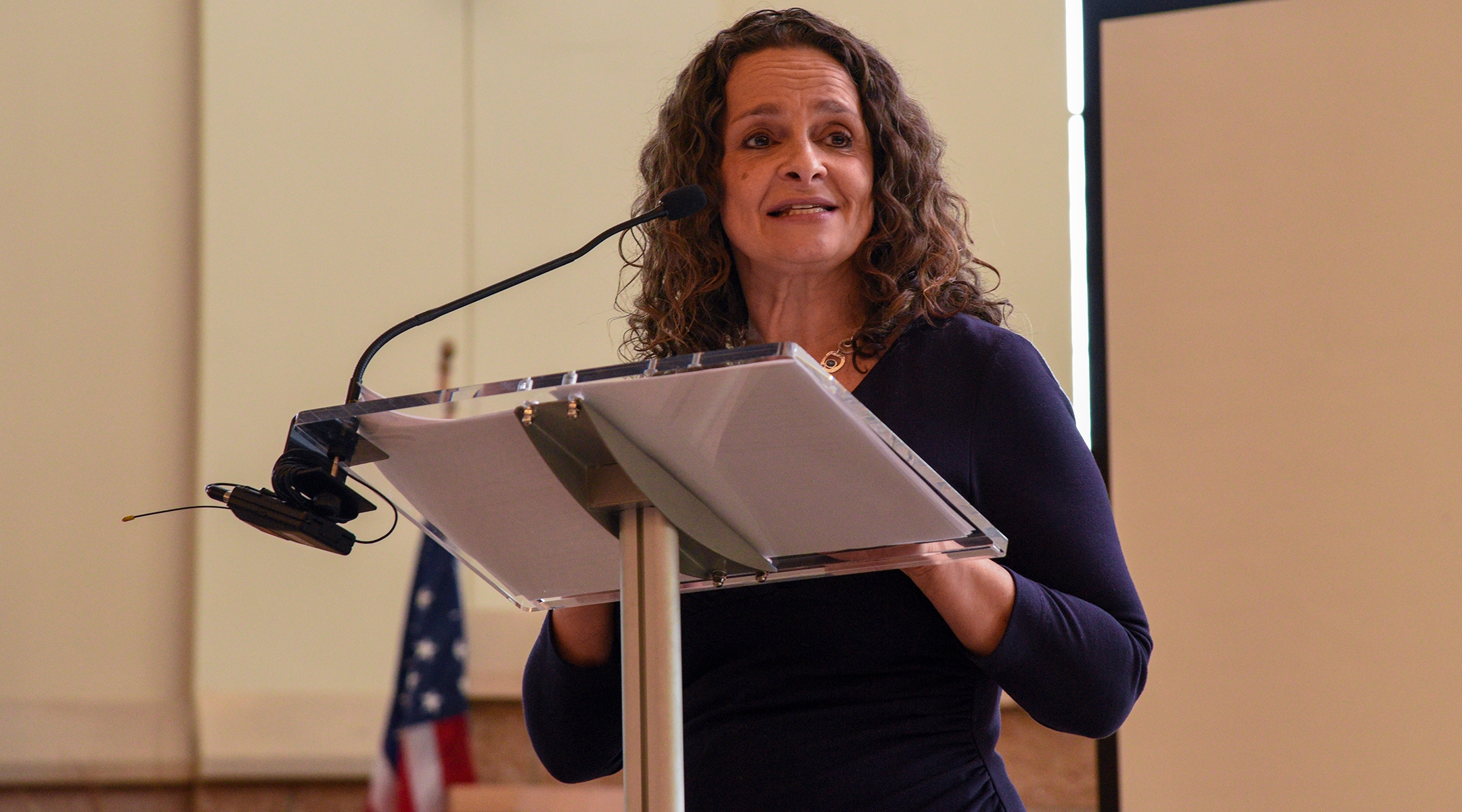
Rabbi Jennie Rosenn speaks at the Colorado Jewish Climate Summit about the importance, history and impact of Jewish climate action. (Courtesy of Colorado Jewish Climate Action)
Some teens interviewed say they were previously engaged in non-denominational climate action, but that Jewish activism serves their needs better. “As an Orthodox Jew, I keep Shabbos, I keep kosher,” said Schafer. “I wanted to be in a place where people would understand me and be respectful of my religious observances, so it just didn’t make sense for me to join [a climate] organization that wasn’t Jewish.”
Their co-director, Marcus-Blank, said that the intersectional nature of JYCM — Jewish, youth, climate — provides space for all her interests. “It allows me to be my full self in a way that I can’t really be in any other space.” She felt limited by other organizations: struggling with not discussing Judaism in secular climate spaces or climate in Jewish spaces, and sometimes, given her age, being ignored in both spaces.
“Being Jewish is what led me to [climate activism],” said Marcus-Blank. Being taught tikkun olam, surrounded by Jews who took action for the things they believed in, contributed to her desire to pursue environmental activism.
Not only can Jewish values like Tikkun Olam be connected to environmentalist principles, but many of those principles are explicitly found in Jewish teachings. Judaism regards human beings as the “guardians of the earth.” It dictates that God created the universe and it is the duty of humans to protect it (stewardship). Nature is woven into much of Judaism — from environmentally related holidays such as Sukkot or Tu Bishvat, to the Tree of Life, a metaphor for the Torah. Jewish tradition also supports modern sustainability concepts such as regenerative agriculture and low waste living.
Nevertheless, the Jewish presence in the climate movement is relatively recent. The first official Jewish-environmentalist organization, named Shomrei Adamah (for the Hebrew phrase “keepers of the earth”) was created in 1988 by Rabbi Ellen Bernstein. The organization’s mission was to “illuminate and make accessible the ecological roots of Jewish tradition and to inspire Jewish individuals and institutions to care for the earth and act on her behalf.” It has since been joined by other groups, such as Adamah (the parent organization of JYCM), which formed with the merger of Hazon and Pearlstone.
Recently, the field of faith-based activism has become more diverse, with interfaith organizations such as Greenfaith gaining prominence. Jewish climate activism also has been increasing as more Jews learn of the scale and speed of the threat.
Through JYCM, teens also learn more about Judaism. Marcus-Blank learned about nigun, a form of sung prayer, at a retreat with JYCM in 2022. During Dayenu’s 2022 “All Our Might”campaign, JYCM youth activist Lexie Miller brought matzah to the leader of a Wells Fargo bank as symbolism for the limited time remaining to fight the climate crisis – just as the Jews had limited time for the matzah to rise.
JYCM also conducts trainings relating Jewish persecution and perseverance to climate action. Miller, who serves on the JYCM national youth leadership board, helps to create ‘equity and inclusion’ resources explaining to youth that now is a time that Jews must fight for survival, just as in the past. “I perceive the threat of climate change very similar to how I felt people in the Torah must have felt when their homes were threatened,” said the 13-year-old from Boulder, Colorado. The concept of justice for Jews and other marginalized groups plays a large role in JYCM’s philosophy. “All of our Jewish teachings tell us to stand up for those who can’t stand up for themselves and to care for the world. That’s why climate activism and [equity and inclusion] is rooted so much in Jewish history,” said Miller.
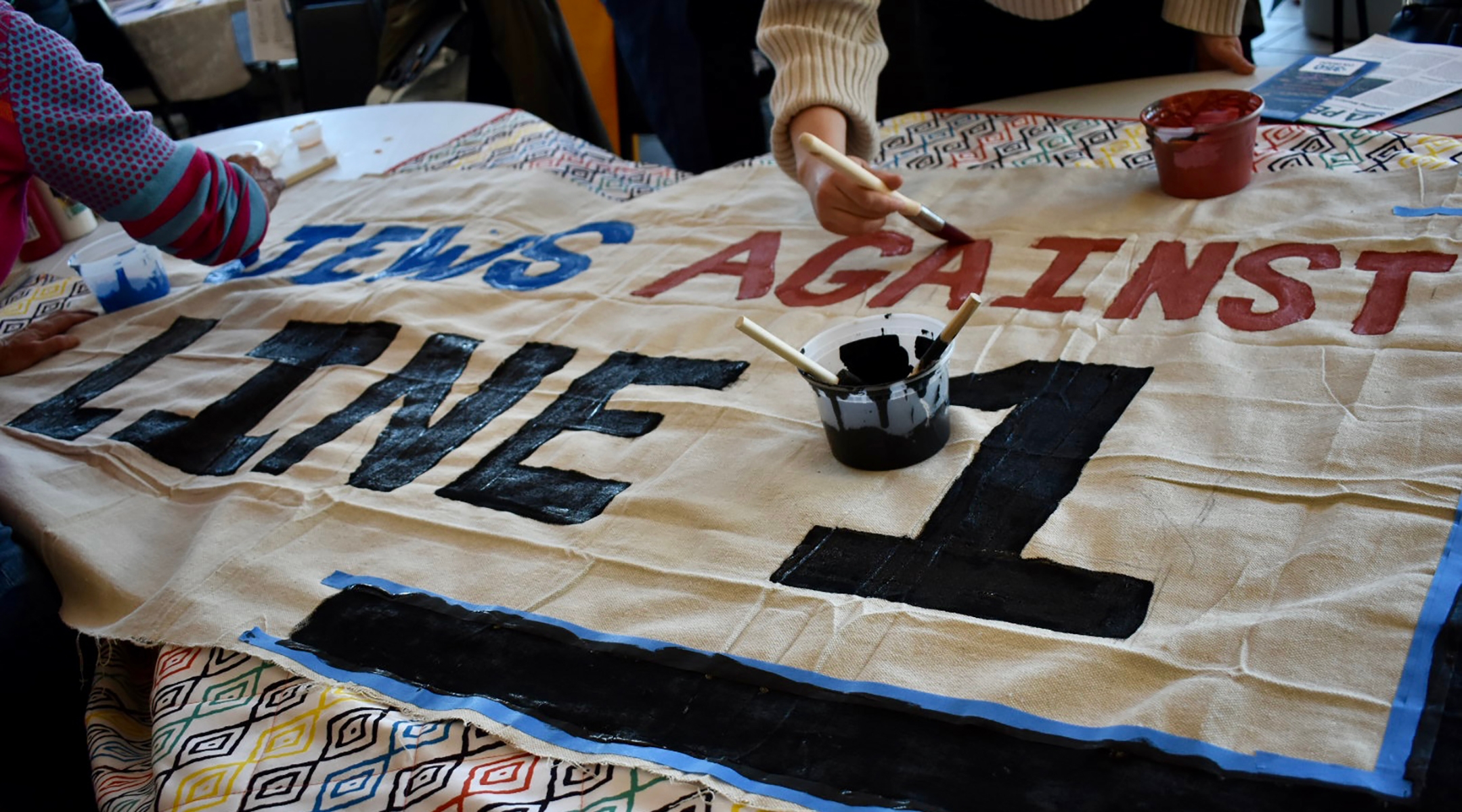
Attendees paint a protest banner during the Colorado Jewish Climate Summit. (Shira Nathan)
For the Colorado Jewish Climate summit, the teens planned with adult organizers for months. The event was similar to others that Jewish teens are coordinating across the country. The summit came to fruition under the direction of Colorado Jewish Climate Action, and included Rabbi Jennie Rosenn of Dayenu and a message from U.S senator Michael Bennet. Colorado Jewish Climate Action hopes to collaborate further with the youth activists; in the future, the Denver kvutzah will serve as a youth outreach partner.
Many teens choose Jewish-based climate action because it fosters community. “[The other teens] inherently understand some of the biggest components of my identity and the things I value,” said Schafer.
Taking action in these groups can also alleviate burnout, a common phenomenon experienced in climate activism. “In this line of work, where you’re facing an existential crisis, it’s not a tangible goal that you’re reaching for. And so it can be really easy to get burned out and be disappointed by the lack of action,” said Marcus-Blank. “JYCM is what kept me going, because these people have so much hope and optimism.”
These teens combine the ideals of youth and deep-seated values of Judaism as fuel for continued engagement in the climate movement; especially l’dor v’dor, “from generation to generation,” the value of preserving/protecting Jewish faith and livelihood in the face of adversity in order for future Jews to benefit,
“There’s a certain urgency that comes with young people, because we are starting to see the effects of climate change in real time. My Jewish values project that urgency because I’m really in tune to wanting to help people,” said Marcus-Blank. “And the persecution of Jews has always created changemakers. So both of those things go hand in hand.”













